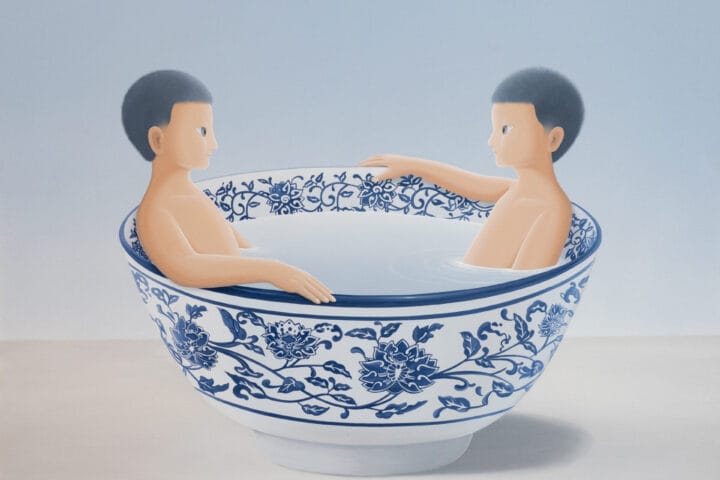Thought missing for decades, the panel will be reunited this week with the artist’s
Struggle series, now on view in an exhibition at The Met that closes November 1, 2020.
The work will also join the exhibition tour, organized by the Peabody Essex Museum, and be on view at subsequent venues through fall 2021.
(New York, October 21, 2020)—The Met announced today the discovery of a painting by esteemed American artist Jacob Lawrence that has been missing for decades. The panel is one of 30 that comprise Lawrence’s powerful epic, Struggle: From the History of the American People (1954–56), and it will be reunited immediately with the series, now on view at The Met through November 1 in Jacob Lawrence: The American Struggle. Titled by the artist There are combustibles in every State, which a spark might set fire to. —Washington, 26 December 1786, the work depicts Shays’ Rebellion, the consequential uprising of struggling farmers in western Massachusetts led by Revolutionary War veteran Daniel Shays; it protested the state’s heavy taxation and spurred the writing of the U.S. Constitution and efforts to strengthen federal power. The panel is number 16 in the Struggle series.
The painting has not been seen publicly since 1960, when the current owners purchased it at a local charity art auction. A recent visitor to The Met’s exhibition, who knew of the existence of an artwork by Lawrence that had been in a neighbor’s collection for years, suspected that the painting might belong to the Struggle series and encouraged the owners to contact the Museum.
The work will be specially featured at The Met and will also join the touring exhibition, organized by the Peabody Essex Museum (PEM), for presentations in Birmingham, Alabama; Seattle, Washington; and Washington, D.C., through next fall.
Max Hollein, Director of The Met, said, “It is rare to make a discovery of this significance in modern art, and it is thrilling that a local visitor is responsible. We are also very excited for our colleagues at the Peabody Essex Museum (PEM), the organizers of the exhibition that inspired this historic find. And most importantly, we are looking forward to having visitors enjoy this new addition—in these final two weeks at The Met and at the upcoming venues of the show.”
Before this discovery, five of the 30 panels painted by Lawrence for the Struggle series were unlocated, and two of those were recorded only by their titles. The “Shays’ Rebellion” panel is one of those. Its existence was known through a brochure that accompanied the first showing of the Struggle series in New York in December 1956 at the Alan Gallery. In May 1958, the panels were exhibited again at the gallery, and had not been seen together as a group until PEM’s 2020 organization of Jacob Lawrence: The American Struggle.
“It was our fervent hope that the missing panels would somehow surface during the run of American Struggle in New York, the city where Lawrence spent most of his life and where the series was last seen publicly,” said Randall Griffey, Curator in the Department of Modern and Contemporary Art, and Sylvia Yount, Lawrence A. Fleischman Curator in Charge of the American Wing, who co-organized The Met’s presentation of the exhibition. “Lawrence’s dynamic treatment of the 1786–87 Shays’ Rebellion reinforces the overall theme of the series—that democratic change is possible only through the actions of engaged citizens, an argument as timely today as it was when the artist produced his radical paintings in the mid-1950s.”
“Since reuniting the Struggle series, the absence of panel 16 has been felt acutely. Represented in our galleries as an empty frame, it was a mystery that we were all eager to solve,” said Brian Kennedy, PEM’s Rose-Marie and Eijk van Otterloo Director and CEO. “We are thrilled to learn of its discovery—one that came about thanks to close looking and careful observation by a museum visitor—and appreciate the generosity of panel 16’s owner to have it join and help relaunch the national tour of Jacob Lawrence: The American Struggle.”
About the Exhibition
Jacob Lawrence: The American Struggle presents the artist’s reinterpretation and reimagining of key moments in the American Revolution and early decades of the republic. This compelling and rarely seen body of work incorporates quotations from primary and secondary historical sources, selected by the artist, that emphasize America’s early fight for independence and expansionism as well as the oft-overlooked contributions and experiences of women and people of color. Lawrence painted Struggle at the height of the Cold War and Joseph McCarthy’s Red Scare, when the civil rights movement was also nascent, and the events of this transformative period deeply informed the artist’s approach to the historical subjects. Lawrence’s more inclusive representation of the nation’s past is no less relevant today and, amid ongoing struggles for social justice and issues of national identity, resonates profoundly.
The exhibition is made possible by the Barrie A. and Deedee Wigmore Foundation and the National Endowment for the Arts.
It is organized by the Peabody Essex Museum, Salem, Massachusetts.
Jacob Lawrence: The American Struggle is curated by Elizabeth Hutton Turner, of the University of Virginia, and Austen Barron Bailly, of Crystal Bridges Museum of American Art, organizing curators, and Lydia Gordon, coordinating curator for the Peabody Essex Museum. The presentation at The Met is co-curated by Randall Griffey, Curator in the Department of Modern and Contemporary Art, and Sylvia Yount, Lawrence A. Fleischman Curator in Charge of the American Wing.
The exhibition is featured on the Museum’s website, as well as on Facebook, Instagram, and Twitter using the hashtag #MetJacobLawrence.










